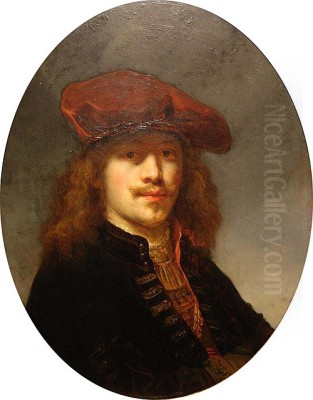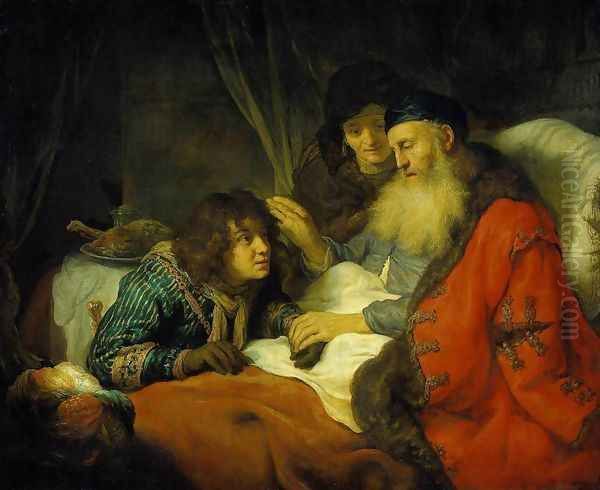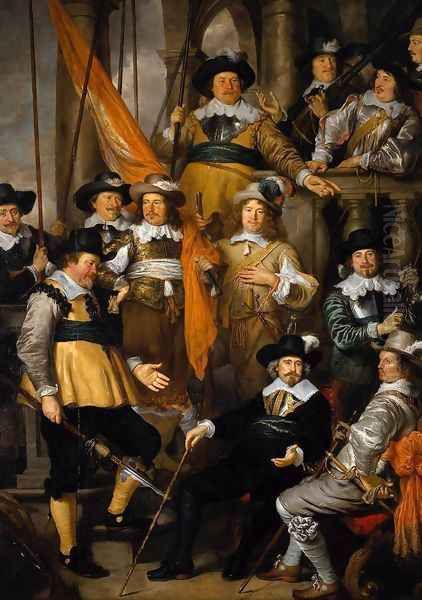
Govert Teunisz. Flinck stands as a significant figure in the rich tapestry of Dutch Golden Age painting. Born on January 25, 1615, in the Duchy of Cleves (now Kleve, Germany), and passing away relatively young on February 2, 1660, in Amsterdam, Flinck navigated the vibrant art world of the Netherlands, initially as one of Rembrandt van Rijn's most promising pupils, and later as a highly successful independent master in his own right. His journey reflects both the powerful influence of his teachers and the dynamic shifts in artistic taste during the mid-17th century.
Early Life and Artistic Awakening in Kleve and Leeuwarden
Govert Flinck's origins lay just outside the Dutch Republic, in the German town of Kleve. His father, a man involved in the silk trade, initially envisioned a similar commercial path for his son. However, the young Flinck harbored a deep-seated passion for drawing and painting, an inclination that would ultimately shape his destiny. His artistic ambitions found crucial support from an unexpected source: a Mennonite preacher named Lambert Jacobsz.
Recognizing Flinck's talent and determination, Jacobsz played a pivotal role in persuading Flinck's father to allow his son to pursue art. Consequently, around 1629 or 1630, Flinck moved to Leeuwarden, the capital of Friesland, to formally study under Jacobsz. Lambert Jacobsz was not only a preacher but also a painter and art dealer, providing Flinck with valuable instruction and exposure to the wider art world. It was in Leeuwarden, under Jacobsz's tutelage, that Flinck laid the foundations of his artistic practice, likely encountering other artists and gaining access to resources within Jacobsz's network. Some scholars suggest he may have worked alongside Jacob Adriaensz Backer during this period, another artist who would later find success in Amsterdam.
The Amsterdam Move and Apprenticeship with Rembrandt
The lure of Amsterdam, the bustling economic and cultural heart of the Dutch Republic, proved irresistible. Around 1633, Govert Flinck made the pivotal move to this thriving metropolis. His primary goal was to enter the workshop of the most famous and influential artist of the time: Rembrandt van Rijn. Flinck was accepted into Rembrandt's studio, which was then a hive of activity, attracting talented pupils eager to learn from the master's innovative techniques.

Flinck spent approximately one year, possibly extending into 1635 or 1636, deeply immersed in Rembrandt's world. During this formative period, he absorbed the master's signature style, characterized by dramatic use of chiaroscuro (strong contrasts between light and dark), expressive brushwork, and profound psychological depth in depicting figures. Flinck proved to be an exceptionally adept student, quickly mastering Rembrandt's manner to such a degree that some of his works from this period were later mistaken for those of Rembrandt himself. He worked alongside other talented individuals in the studio, potentially including artists like Ferdinand Bol, who would also emerge as a significant painter.
Forging an Independent Path: Style Evolution
While his training under Rembrandt provided an invaluable foundation, Govert Flinck did not remain solely an imitator. By the late 1630s and increasingly through the 1640s, he began to forge his own distinct artistic identity. This evolution involved a gradual departure from the intense drama and rougher textures often found in Rembrandt's work. Flinck's style shifted towards a brighter palette, smoother finishes, and a more elegant, sometimes even idealized, representation of his subjects.
This stylistic transition was partly a response to changing tastes among Amsterdam's wealthy patrons, who increasingly favored a more refined, classical, and internationally influenced aesthetic. Flinck proved adept at meeting this demand. His later work shows the influence of Flemish masters, particularly the elegant portraiture associated with Anthony van Dyck and the vibrant color and dynamic compositions of Peter Paul Rubens. He also looked towards successful Amsterdam contemporaries like Bartolomeus van der Helst, whose polished and detailed portraits were immensely popular. Flinck successfully synthesized these influences into a style that was both sophisticated and appealing.
Master Portraitist of Amsterdam's Elite
Govert Flinck rapidly gained renown as a portrait painter, becoming one of the most sought-after artists in Amsterdam for commissioned likenesses. His ability to capture not only the physical appearance but also the status and character of his sitters made him a favorite among the city's affluent merchants, civic leaders, and intellectuals. For a time, his popularity in this genre rivaled, and perhaps even surpassed, that of his former master, Rembrandt.

His portraits are characterized by their clarity, refined execution, and often a sense of calm dignity. A fine example is the Portrait of Margaretha Tulp (1643), daughter of the famous Dr. Nicolaes Tulp (immortalized in Rembrandt's Anatomy Lesson). The painting showcases Flinck's skill in rendering luxurious fabrics and conveying the sitter's poise with a smooth, elegant finish. An interesting anecdote highlighting his skill involves a portrait of Rembrandt's wife, Saskia van Uylenburgh. For many years, this work was attributed to Rembrandt, but later art historical analysis confirmed it as a work by Flinck, demonstrating how closely he could emulate the master's style when desired, yet also hinting at the quality that led to such confusion. His technical proficiency was noted, with some speculation arising, for instance, that for the Margaretha Tulp portrait, he might have employed different models for the head and body, or perhaps utilized optical aids like projection techniques, reflecting contemporary studio practices aimed at efficiency and accuracy.
Narratives of History and Faith
Beyond portraiture, Flinck was also a highly accomplished painter of historical, mythological, and biblical scenes. These history paintings allowed him to showcase his skills in composition, narrative, and the depiction of the human figure in dramatic contexts. His early history works often retain a strong Rembrandtesque flavor in their use of light and shadow, but his later works in this genre also reflect his stylistic shift towards greater clarity and classical balance.
One of his notable early history paintings is Isaac Blessing Jacob (dated 1638, though sometimes referred to as Jacob Blessing Issachar in sources). This work, depicting the poignant biblical story of deception and blessing, demonstrates his mastery of dramatic lighting learned from Rembrandt, but perhaps with a slightly clearer narrative structure. The painting itself has a dramatic history: it was reportedly taken by the French during the Franco-Dutch War and only returned to the Netherlands, eventually finding its home in the Rijksmuseum, Amsterdam, in 1815.
Other significant history paintings include Solomon's Prayer for Wisdom (1649) and Christ Holding the Cross (also 1649, now in the Suermondt-Ludwig-Museum, Aachen after being donated in 1882 and subsequently restored). These works exemplify his mature history style, often characterized by well-ordered compositions, rich colors, and expressive figures rendered with a smoother finish than his earliest works. He also painted allegorical subjects, such as the Allegory on the Memory of Prince Frederick Henry (1654), demonstrating his versatility.
Civic Pride: Group Portraits and the Town Hall Commission
Like many successful Dutch painters, Flinck received prestigious commissions for group portraits, particularly those depicting the civic guards or militia companies of Amsterdam. These large-scale works were important symbols of civic pride and social cohesion. Flinck completed notable examples, including The Company of Captain Albert Bas and Lieutenant Lucas Conijn (1642) and The Company of Captain Joan Huydecoper and Lieutenant Frans van Waveren (1650). These paintings demonstrate his ability to manage complex compositions involving multiple figures, capturing individual likenesses while creating a harmonious and impressive group dynamic. They stand as important documents of Amsterdam's social structure and Flinck's high standing within the city's art scene.

Perhaps the most significant commission of Flinck's career came towards the end of his life. He was chosen to execute a series of large historical paintings for the lunettes (semicircular spaces) in the vast Citizen's Hall (Burgerzaal) of the newly built Amsterdam Town Hall (now the Royal Palace on Dam Square). This was arguably the most prestigious decorative project in the Netherlands at the time. Flinck was tasked with depicting scenes from the history of the Batavians, considered the ancestors of the Dutch, and heroic episodes from Roman history, such as Manius Curius Dentatus Refusing the Gifts of the Samnites.
Tragically, Flinck's health declined rapidly, and he died on February 2, 1660, at the age of 45, before he could complete this monumental undertaking. His death left a void in the project, which was subsequently divided among several other prominent artists. Juriaen Ovens initially completed some of Flinck's designs. The commission was then distributed further, involving the renowned Flemish master Jacob Jordaens, Flinck's former master Rembrandt (whose powerful The Conspiracy of Claudius Civilis was controversially rejected and removed), and Jan Lievens, another artist with connections to Rembrandt's circle. Flinck's inability to complete this grand project remains one of the poignant 'what ifs' of Dutch art history.
Studio Practices, Market Presence, and Contemporaries
Govert Flinck operated a successful studio and navigated the competitive Amsterdam art market effectively. His shift towards a brighter, more elegant style aligned well with prevailing tastes, allowing him to compete successfully with artists like Bartolomeus van der Helst. He also maintained connections with fellow artists who emerged from Rembrandt's workshop, such as Ferdinand Bol. Flinck and Bol are often discussed together, as both developed successful careers by adapting elements of Rembrandt's style into a more polished and accessible manner, sometimes referred to as a "bright style," which found favor with patrons.
While direct collaborations are not extensively documented beyond the master-pupil relationship, the artistic environment of Amsterdam fostered both rivalry and shared stylistic developments. Flinck's success demonstrates his business acumen as well as his artistic talent. He was clearly aware of market demands and adapted his style accordingly, without entirely sacrificing the powerful lessons learned from Rembrandt and Lambert Jacobsz. His contemporaries included not only the aforementioned painters but also figures like Nicolaes Maes, another Rembrandt pupil who specialized in genre scenes and later portraits, and Gerard Dou, Rembrandt's first pupil known for his meticulous 'fijnschilder' technique.
Legacy, Collections, and Auction Records
Despite his relatively short life, Govert Flinck left a significant legacy as one of the leading painters of the Dutch Golden Age. His work bridges the gap between the dramatic intensity of the early Baroque, exemplified by Rembrandt, and the more classical, elegant trends that gained prominence in the latter half of the 17th century. He excelled in multiple genres, leaving behind a substantial body of work that includes compelling portraits, dynamic history paintings, and important civic group portraits.
Today, Flinck's paintings are held in major museums around the world. The Rijksmuseum in Amsterdam holds several key works, including the group portraits and Isaac Blessing Jacob. Other notable holdings include the Head of an Old Man at the National Gallery of Ireland in Dublin, and a Portrait of a Lady at the North Carolina Museum of Art in Raleigh. His Christ Holding the Cross is in the Suermondt-Ludwig-Museum in Aachen. Works can also be found in collections such as the Wallace Collection in London and the Louvre in Paris, among others.
Flinck's paintings continue to command respect and high prices on the art market. A testament to his enduring appeal was the sale of his painting An Old Man in a Niche at Christie's, New York, on April 27, 2017, which achieved a remarkable price of $10,327,500. Earlier auction records also note the sale of works like a Portrait of a Young Woman Holding an Orange at Sotheby's, New York, in January 1994. The provenance of a Self-Portrait, identified at a Christie's sale in London in 1943 and confirmed again in 1980, further highlights the ongoing interest in his life and work.
Conclusion: An Independent Master
Govert Flinck's artistic journey is a compelling narrative of talent, ambition, and adaptation within the dynamic environment of the Dutch Golden Age. Emerging from the formidable shadow of Rembrandt van Rijn, he absorbed the master's lessons on light, drama, and human emotion. Yet, Flinck possessed the skill and artistic vision to evolve, forging an independent style characterized by greater elegance, clarity, and refinement. This adaptation brought him immense success, making him one of Amsterdam's most sought-after painters for portraits and historical scenes. Though his life was cut short before he could complete his most prestigious commission, Govert Flinck's contribution to Dutch art remains undeniable. He stands as a testament to the diversity and brilliance of painting during this remarkable period, a master who successfully navigated the complex interplay of influence, personal vision, and public taste.